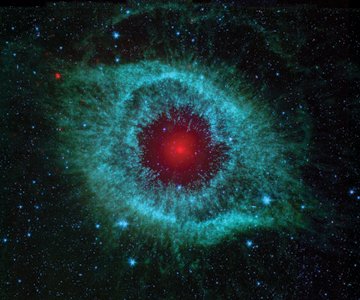A dead star’s dusty ring
Astronomers have observed the dusty remains of a planetary system around a dead star.
By Emily Sohn
In 5 billion years, the sun will swell into a huge ball that will fry Earth or even swallow it up. Our star’s outer layers will then fly off, and its core will shrink into a dense, fading object called a white dwarf.
Then what? New images of a dead star are giving scientists a glimpse of what might happen to our solar system when its time comes.
 |
|
Dust (central red cloud) surrounds a white dwarf in the famous Helix nebula.
|
| Su et al., University of Arizona, JPL/NASA |
The observations come from the Spitzer Space Telescope, which recently focused on a huge, eye-shaped cloud of gas and dust called the Helix nebula, 700 light-years from Earth.
The Helix nebula contains the leftover debris that a star spewed as it collapsed. Inside lies a white dwarf that is still hot. This means that the star died only recently.
At first, scientists were puzzled by Spitzer’s infrared images of the Helix nebula. When the star’s outer layers flew off, the researchers expected any extra dust to get pushed away, too.
Instead, the images showed lots of dust hovering around the white dwarf, between 35 and 150 astronomical units (AU) away. One AU is the distance between the sun and Earth.
In our solar system, many comets orbit the sun within a region called the Kuiper belt, beyond Neptune. Helix’s star might have had orbiting comets, too. The scientists propose that, when the star went poof, its comets started to collide and crumble, creating the distant dust ring.
Previously, astronomers had found dusty rings around even older white dwarfs whose nebulae were long gone. Spitzer studies of one of these old stars found that the dust was made up of the same stuff as a typical comet.
Other studies have turned up 40 white dwarfs with atmospheres that contain unexpectedly high levels of certain metals, including sodium. So, scientists suspect that these white dwarfs captured the remains of ancient planets, which originally contained the metals.
“We’re starting to think [that the metals] are probably the smile on the crocodile,” says Marc J. Kuchner of NASA’s Goddard Space Flight Center in Greenbelt, Md., “the last bits remaining of a dead planetary system, fed to the white dwarf.”—E. Sohn
Going Deeper:
Cowen, Ron. 2007. On the trail of dead planets: Dust ring around a white dwarf. Science News 171(Feb. 17):100. Available at http://www.sciencenews.org/articles/20070217/fob3.asp .
Sohn, Emily. 2007. A star’s belt of dust and rocks. Science News for Kids (Jan. 10). Available at http://www.sciencenewsforkids.org/articles/20070110/Note2.asp .
______. 2004. Planets on the edge. Science News for Kids (April 7). Available at http://www.sciencenewsforkids.org/articles/20040407/Feature1.asp .







